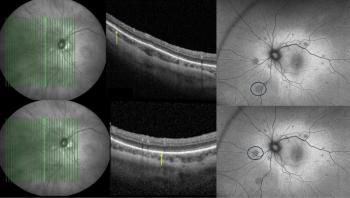
12-month results with small-aperture IOL providing patients with an extended range of vision
The IC-8 IOL (AcuFocus) is one of the new class of extended-depth-of-focus (EDOF) IOLs that is definitively altering the landscape of cataract surgery in Europe and around the world. Whereas monofocal and multifocal lenses have one or two distinct focal points, an EDOF-IOL creates one elongated focal point, though each lens does so in a different way.
By Robert Ang, MD
The IC-8 IOL (AcuFocus) is one of the new class of extended-depth-of-focus (EDOF) IOLs that is definitively altering the landscape of cataract surgery in Europe and around the world. Whereas monofocal and multifocal lenses have one or two distinct focal points, an EDOF-IOL creates one elongated focal point, though each lens does so in a different way.
This technology is able to manage patient needs for presbyopia correction without compromising near or distance functional vision.
The IC-8 IOL is made of hydrophobic acrylic material, similar to monofocal lenses on the market save for the addition of a black circular mask that is embedded into the IOL (Figure 1). Using the same concept as the successful KAMRA inlay (AcuFocus), the small-aperture IOL blocks unfocused rays of light and extends the depth of field, improving distance as well as near and intermediate vision.
Benefits of the IC-8 IOL
This IOL is an excellent option for a wide variety of patients, from basic presbyopic patients to challenging cases, because it works well in ametropic, emmetropic and post-LASIK presbyopes as well as monofocal pseudophakic patients. Additionally, vitreoretinal surgery can easily be performed in eyes implanted with the IC-8 IOL.1–3 It has also been reported to aid in reducing light sensitivity and spectacle dependence.4
One of the most significant benefits was discovered when we found that the pinhole effect blocks the degradation of vision from a corneal astigmatism of up to 1.5 D. In initial surgeries, we realised that, even in refraction, with 1.0 to 1.2 D of astigmatism, the patient was seeing 20/25 uncorrected.
The aperture enables astigmatism tolerance within this range. As astigmatism increases beyond 1.5 D, distance vision degrades proportionally as it does with any lens and it becomes necessary to use a toric or monofocal lens. However, for a patient with 1.5 D or less, which fortunately encompasses most of my patients, I use the IC-8 IOL.
When we operate, we cannot predict if we will induce or change astigmatism. We may induce more, or the axis may change, along with a host of other unpredictable issues. With most multifocal IOLs, a deviation of more than 0.50 D from the intended refractive target will result in the loss of one or two lines of uncorrected distance visual acuity (UDVA).
Another substantial benefit of the IC-8 IOL is its ability to tolerate ±1.00 D manifest refractive spherical equivalent deviation from the intended refractive target, with no appreciable change in acuity, at all distances.
The forgiveness in terms of astigmatism and refractive target, and the spherical nature of the lens, combine to make a greatly simplified cataract procedure. During toric lens implantation, the IOL power must first be calculated along with any corneal astigmatism. Then the axis is determined and marked both at the slit lamp and intraoperatively. Lens extraction is performed, and the IOL inserted and rotated into position.
There is no guarantee that the target will be reached or that the lens will stay in position, and even the smallest degree of rotation could considerably affect the effectiveness of the astigmatism correction. With the IC-8 IOL, these concerns are not present. The IOL power is calculated, the lens extracted, and the IOL inserted and rotated into position.
This is a wonderful feature, especially for patients who have had previous LASIK or have other issues, such as corneal aberrations or a previous radial keratotomy, which can make it difficult to compute power. Using the IC-8 IOL gives me much greater confidence in my outcomes, knowing that even if the target is off in terms of refraction, cylinder or sphere, the small aperture is forgiving and can mask the effect.
12-month outcomes
I recently reported on 34 eyes that have reached 1 year of follow-up following implantation with the IC-8 (Figure 2).4 The mean refractive spherical equivalent is –0.51 D. This is very close to our target of -0.5 to -0.75 D. Mean UDVA is 20/25, mean uncorrected intermediate visual acuity (UIVA) 20/20 and mean uncorrected near visual acuity (UNVA) 20/25.
These 12-month outcomes demonstrate that implantation provides a continuous, broad range of vision and excellent acuity across all focal distances. Monocular UDVA, UIVA and UNVA improved significantly and remained stable to 12 months. All patients achieved 20/32 or better in the implant eye at distance, intermediate and near vision at 12 months. Additionally, 100% of eyes maintained 20/40 or better visual acuity over the range +0.50 D to –1.50 D of defocus.
Some may assume that an IOL with a mask would diminish light; however, patients have not complained of issues related to night vision, nor do they notice that their vision is dimmer. There have been few complaints about glare and haloes, a regular concern when implanting multifocal IOLs.
We have conducted visual field and other traditional tests and have found them to be unaffected by the small-aperture IOL. If the patient develops posterior capsular opacity, a YAG capsulotomy can be performed outside the outer rim of the mask. I have done this, and the sheet of posterior capsule just floats off. As long as it is performed outside the small aperture, vision improves and the patient does well.
The IC-8 IOL is definitely the most forgiving of all the lenses with which I have experience. Even better, as the implantation procedure is the same in-the-bag procedure as a typical IOL, without the preoperative computations and guesswork, surgeons do not need to change any of their techniques. They only need to follow the targeting guidelines and the IOL takes care of the rest.
References
1. Results from an animal study conducted by Dr Barry Kupperman, Professor of Ophthalmology and Biomedical Engineering; Chief, Retina Service; Vice-Chair, Clinical Research, Ophthalmology at UC Irvine School of Medicine.
2. T. Schultz and B. Dick. J. Refract. Surg. 2016; 32 (10): 706-708.
3. B. Dick. Ophthalmol. 2016; 0116: 402. https://theophthalmologist.com/issues/0116/a-study-in-small-apertures. Accessed February 23, 2017.
4. Data courtesy of Robert Ang, MD.
Newsletter
Get the essential updates shaping the future of pharma manufacturing and compliance—subscribe today to Pharmaceutical Technology and never miss a breakthrough.













































